Money savvy saver Jordon Cox shares his money saving ideas with www.nhsdiscountoffers.co.uk, as the 24yr old expert tells us how he makes massive savings in the supermarket, just by using a few tricks that shoppers just don’t know about.
Here is his story…
“….Most people spend more time in supermarkets than any other shop – but over the years the grocery giants have mastered the tricks to getting customers to spend more.
According to the Office for National Statistics from 2019, the average UK household spends £3,224 on groceries every single year. Higher than most other average monthly bills….”

Jordon shares his money saving supermarket tips with us
“….Buying groceries is essential for us all – so it’s not like we can cut it out to save money. However there are ways to drop that sky high food price down a little bit. Because supermarkets have been at it for so many years – they know how to get you to spend the most money.
Once you know the tricks of the trade that supermarkets use to jump up the price of your basket, you can try to avoid them, and potentially save hundreds on your shopping. From downshifting, to switching aisles and even shopping at the right time – here are some tips to cut down your supermarket shopping bill by £100s or even £1,000s each year: Remember you can also save on nhs discounts too.
1) Downshift Your Shopping
We Brits can be brand snobs, where we stick to what we know – which is usually the brands everyone recognises.
This can be very expensive however, as you could be paying up to 70% extra just for having a recognisable name on the box.
Downshifting is the practice of shifting down one brand level when shopping – to see if you like a cheaper alternative.
So if you buy the ‘finest’ or ‘taste the difference’ range, drop down to branded. If you buy branded, drop to the supermarket own brand. And if you buy the supermarket own brand, buy the ‘value’ range.
This not only saves you money, but if you like or prefer the cheaper option, you’ll have a new go-to item, which can pile up the savings over time to the tune of £10s or £100s a year.
Quite often, a lot of the name brands are made in the same factory and have the same ingredients – so there may not even be a difference… only the price.
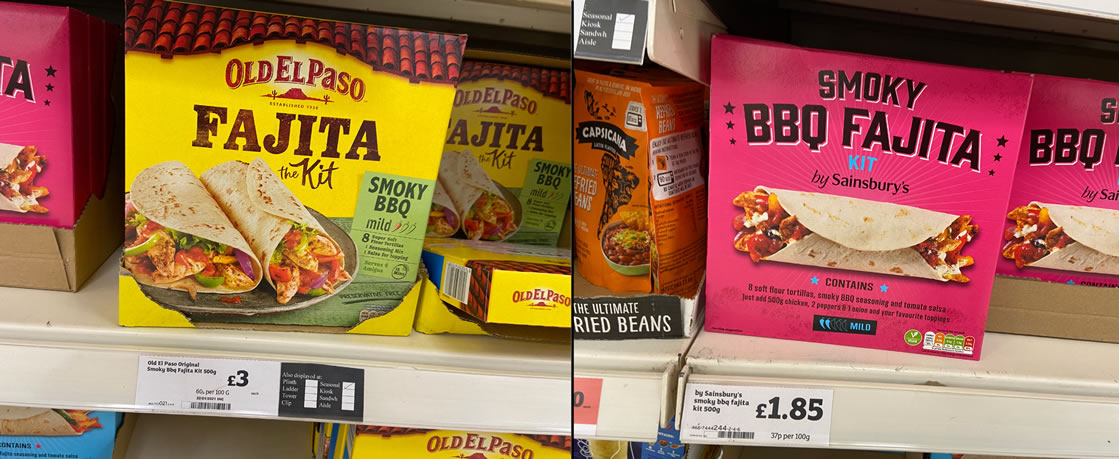
Jordon saved £1.15 on this Fajita kit by simply buying Sainsburys own rather than the branded El Paso.
2) Shop In The World Foods Aisle
For most people – the world foods aisle at the supermarket is not even thought about. The common misconception is that everything is overpriced, as it’s been imported – and that is correct for some items, but not others.
If you’re shopping in that aisle for Twinkies or Marshmallow Fluff – yes you’ll pay a premium. But items such as rice, sauces and spices can actually end up far cheaper.
When searching in my local Sainsbury’s, one of the best examples I found was a 100g bag of Natco Paprika Power for 80p.
If you wanted a comparable jar from the spice aisle – the cheapest was Sainsbury’s own brand at 85p… but for 44g (less than half). If you bought the name brand of Schwartz – you’d be paying even more.
The difference in price and size meant the world food item was 8p per 10g – and the cheapest spice aisle was 19.8p per 10g.
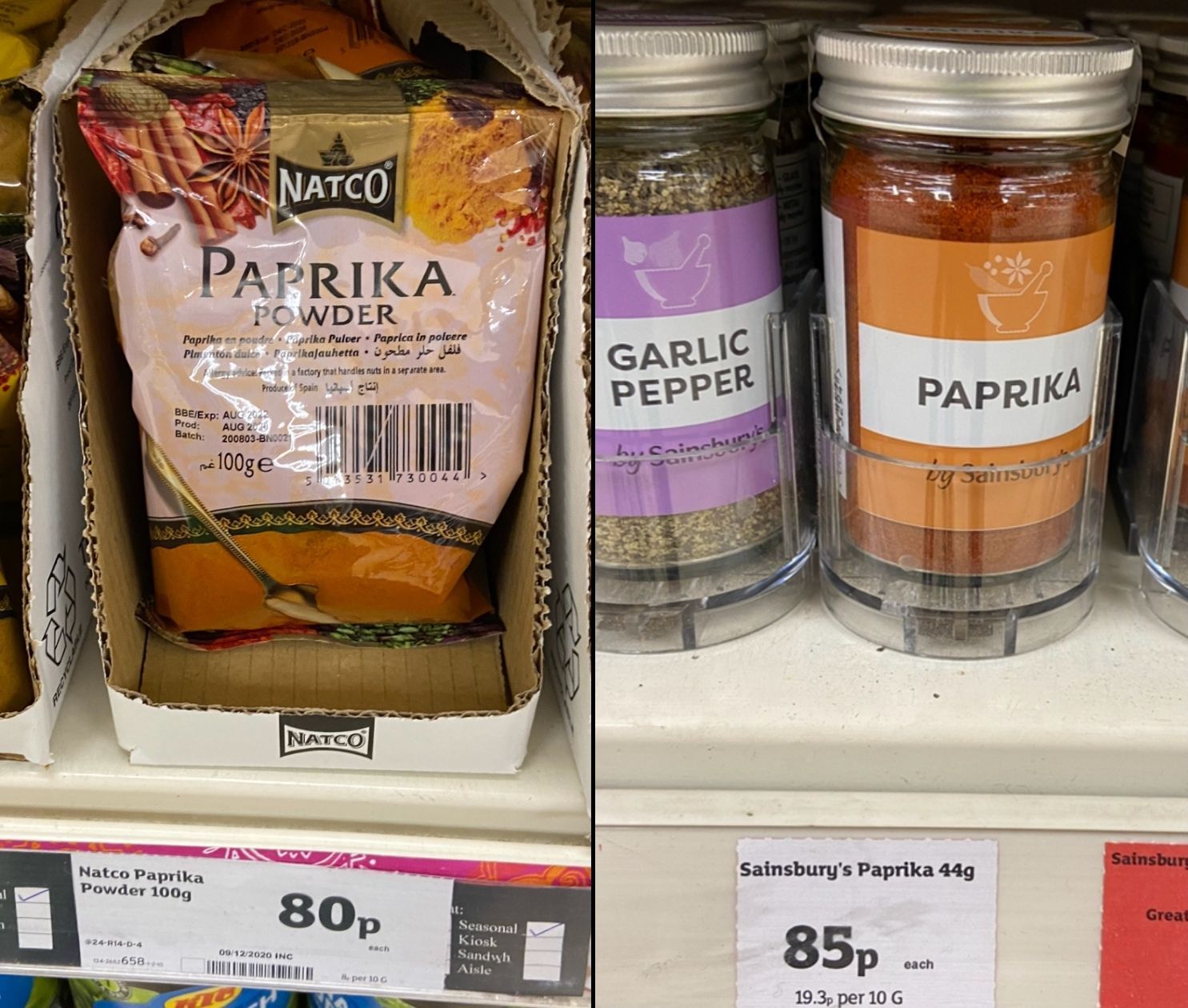
Jordon found shopping in the World Food Aisle can save you money on your spend
3) Complain If Things Go Wrong
We are all stereotypically British in the fact that if something goes wrong, we usually keep quiet about it… but you shouldn’t.
If there is something genuinely wrong with something you buy, either tell the supermarket or the brand what the problem is.
It’s perfectly reasonable under the consumer rights act to ask for a refund on faulty goods – but more often than not, as a gesture of goodwill, supermarkets and brands send you coupons or gift cards for more than the item is worth.
I once complained to Mars chocolates that a tub of Celebrations didn’t have a single Malteasers chocolate in it. Genuinely the most heartbreaking moment of my life.
This was obviously a fault however, so I emailed in, gave the batch number, and got sent £10 worth of coupons in the post for more chocolate – so actually made a profit. It pays to complain!
4) Shop In The Baby Aisle (Even If You Don’t Have A Kid)
Because supermarkets are so big with a massive variety of products, there are sometimes the same product sold in several different aisles.
On occasions, they may change the packaging & price to make it look like a different product, despite it being nearly identical.
The best examples of this are in the baby aisle instead of the beauty aisle.
If you were looking for some cosmetic cotton buds in the beauty aisle – you could pay nearly double the price of a pack of 200 baby cotton buds. When in fact – they are the same item with different packaging.
Most supermarkets are guilty of this – and here’s an example online at Waitrose. If they look the same – it’s because they probably are. But you’re paying double for the same amount.
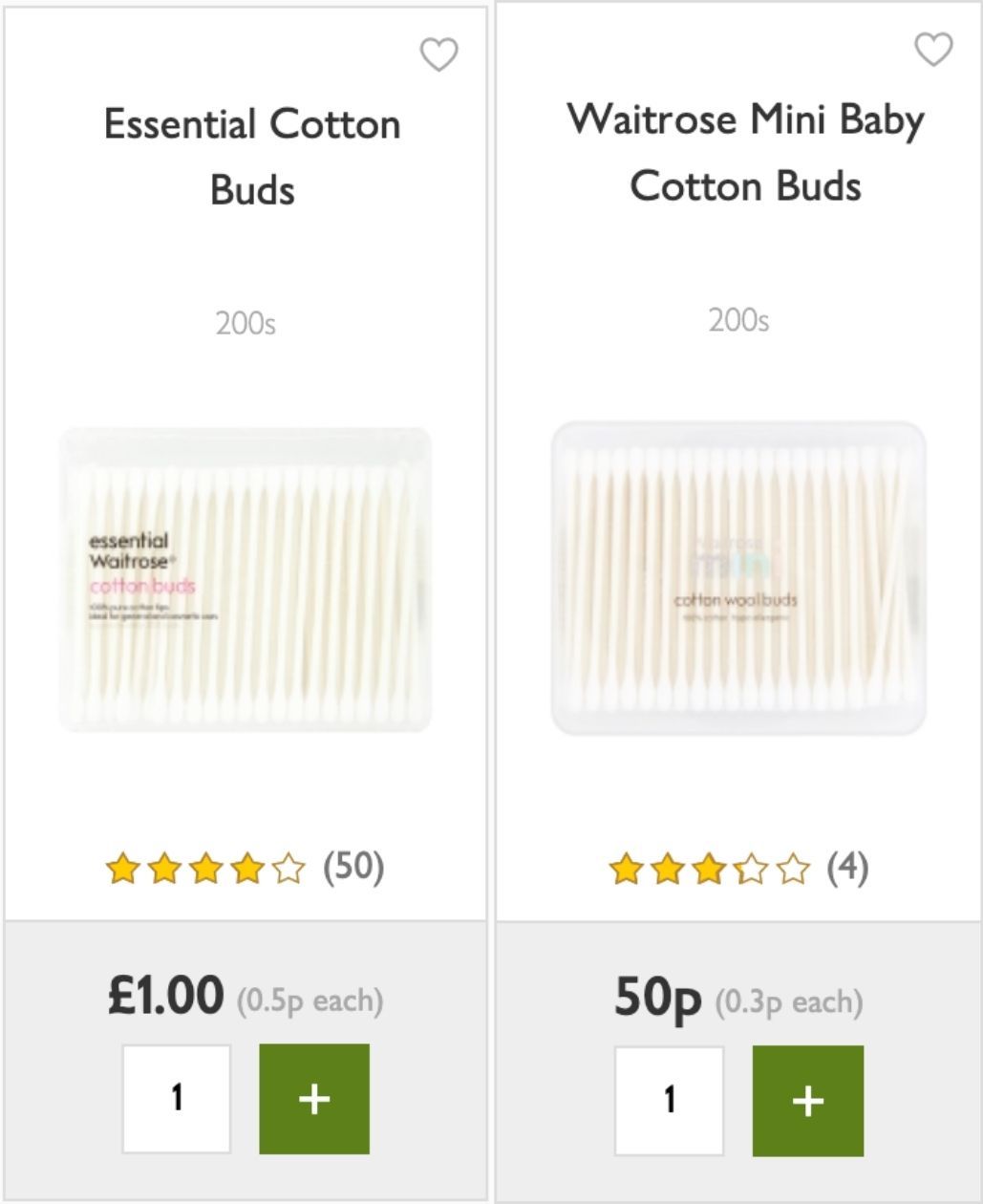
Some items such as cotton buds are more expensive as they are sold in the ‘Beauty’ section rather than ‘baby’ section.
5) Look High And Low On Shelves
Supermarkets seem to put either the most expensive items, or the ones they most want to sell at eye level.
They want your eyes to naturally gravitate to the shelf you’re eye level with, instead of gazing up and down looking for other items.
Quite often you’ll find the best deals tucked away either down low, up high or the the corners of aisles – as these aren’t places shoppers tend to look the most.
When walking through a sauce aisle at Sainsbury’s, although there are many different sauces on offer, you can see the bottom shelf is the only shelf that has something on sale. And its alternative is right at eye level and full price.
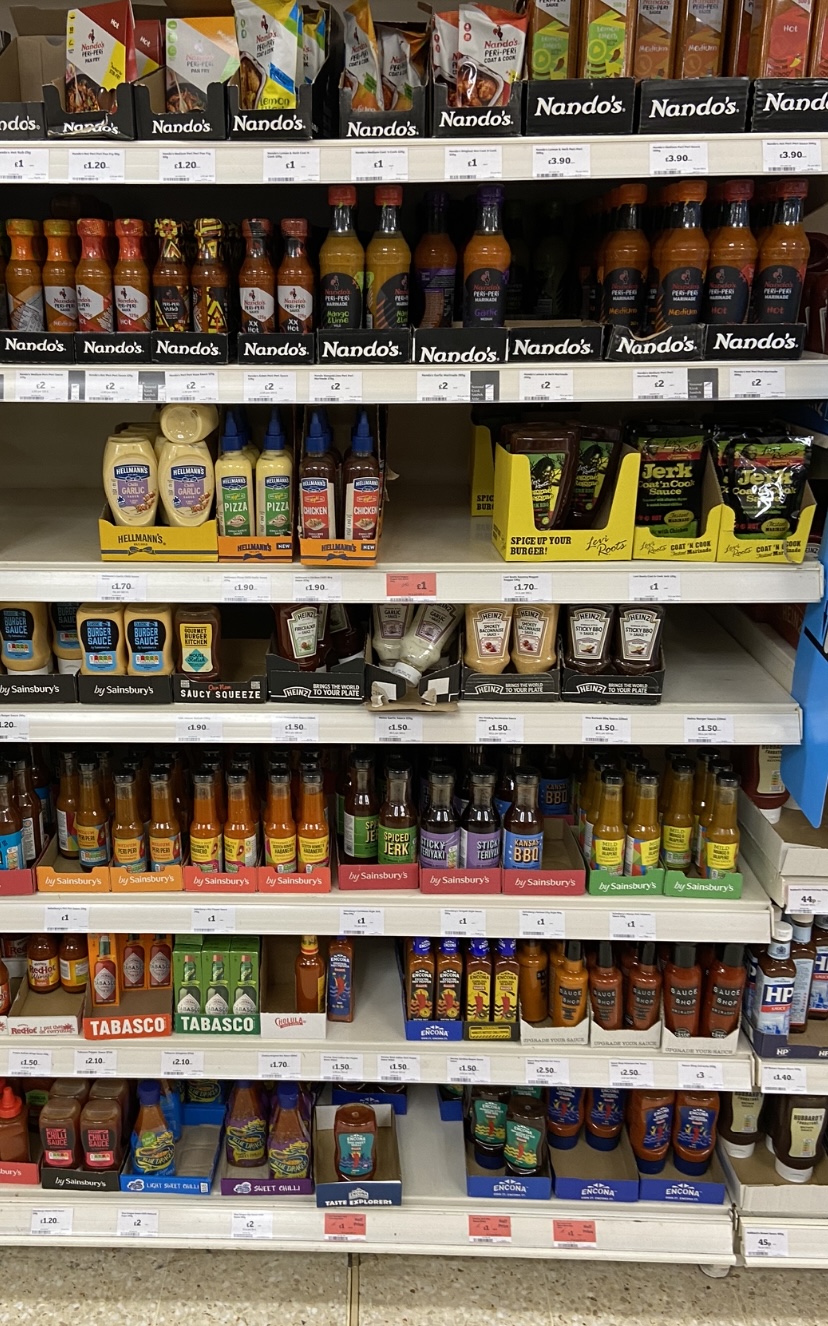
The most expensive items are always at shoppers eye level – gaze up and down a shelf for a bargain
6) Yellow Sticker Discounts
At the end of each day, supermarkets have a lot of food going out of date that would otherwise be thrown away. So instead, they stick a reduced sticker on it and try to sell it off cheap.
This is where you can get a lot of bargain food. You’ll quite often find a fridge full of items reduced, which you’re able to pick up cheaply and eat that day, or take it home to freeze.
Each supermarket starts reducing products at different times, but on the whole you can start to see discounts from 12pm, with the largest discounts (up to 90% off) at around an hour before closing time.
You can usually find yellow sticker discounts in the chilled aisles and the bakery sections – but keep an eye out wherever you walk for the yellow glint.
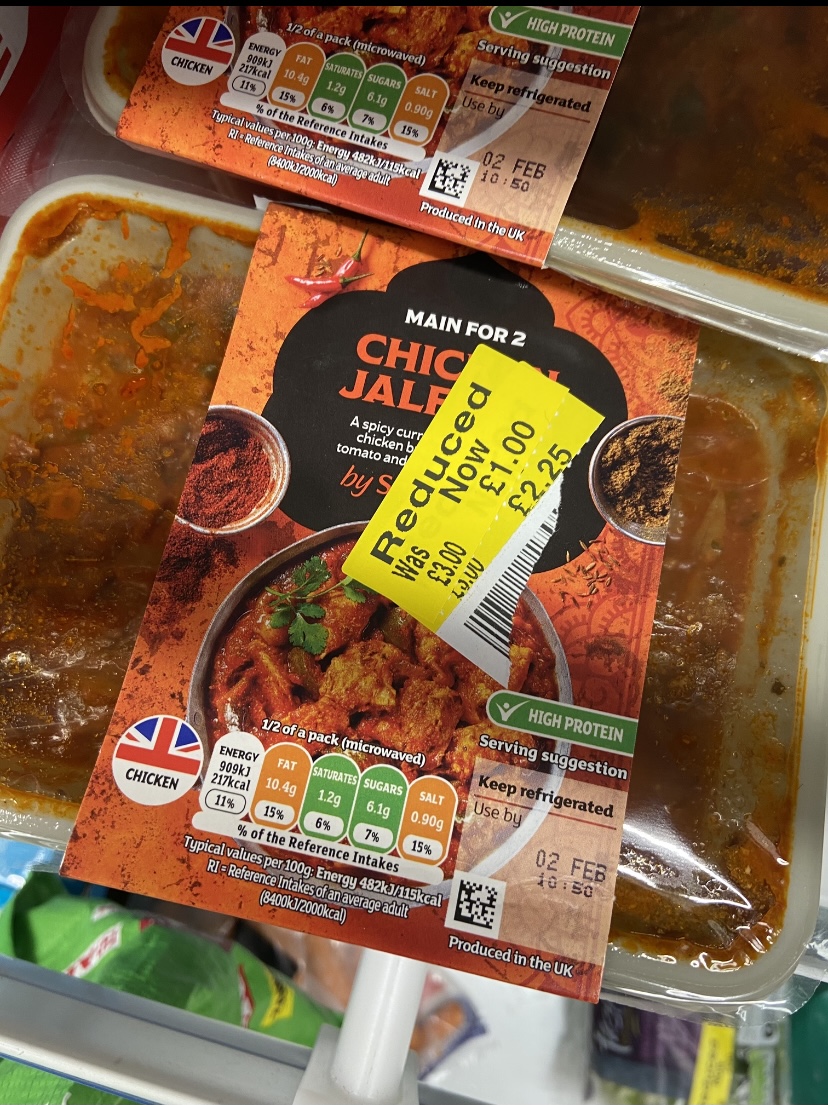
Keep an eye out for the yellow stickers – you can save a massive amount.
7) Switching Your Medicine
When it comes to pills and medicine for pain relief, cold & flu or indigestion – there’s only one type you should be buying – supermarket own brands.
No matter what medicine it is, both the name brand and the supermarket own brands both have the same active ingredient most of the time. That should mean they do the exact same job at stopping your pain.
You can check the ingredients on each pack, and as long as the active ingredient is the same – it’s totally fine and safe to buy the cheaper one.
The difference can be huge too. Buying the standard Ibuprofen instead of Nurofen can save you £1.50 per box – and both contain 200mg of ibuprofen with extra ingredients for the coating.
A few different medicines also share the same ‘PL number’, which is given to a certain drug made by a certain company. Don’t be surprised if your Gaviscon shares the same PL number as a cheaper brand – and that’ll mean it’s the same medicine instead with ingredients exactly the same.

Standard Ibuprofen instead of Nurofen can save you £1.50 per box
8) ’Value Packs’ Aren’t Always The Best Value
This probably goes without saying – but you should never take a supermarket’s word for it! Just because a pack of something says ‘value pack’ or ’50% extra’ doesn’t make it the cheapest.
You do have to be beady-eyed in the supermarket, as prices change all the time. It’s not unusual that buying two smaller packs it cheaper and more cost effective than buying the larger ‘value packs’.
Something you should always do is check the price per 100ml/g when you buy anything. It’ll tell you which one works out cheapest gram for gram – so you can get a measure for how good of a deal things actually are.
9) Don’t Be Duped Into ‘Thins’ Or ‘Minis’
There’s been a bit of a craze recently of brands releasing ‘thins’ and ‘mini’ packs of popular products. This may be great for variety, but not great if you’re looking for the best value.
This can be found mostly on biscuits and crackers, and it can cost you twice as much to have the thinner variety.
One example being Mcvities chocolate digestive biscuits. The ‘thins’ pack costs £1.59 for 180g – but the standard pack you can pick up for £1.35 and 266g in weight.
The ‘thins’ pack is prices at 88p per 100g, while the usual pack is 51p per 100g – so there’s quite a big difference.
10) Bulk Buy If There’s A Good Deal
Supermarket offers can be a great deal from time to time – and if you see one, there’s nothing to stop you buying more than one.
This is especially true for non perishables like toothpaste, toilet paper and shampoo. If you have room for them.
It makes sense that if you see a price on something that is low (and you’re likely to buy again in the coming weeks), then grab a few.
The last thing you want to do is buy something at full price (if you can help it), so the more you can buy at the cheapest price – the better.
Armed with this knowledge so you won’t get ripped off in the supermarket – you should be saving £100s each year by putting this into practice.
There’s no fancy gimmicks either – commit these to knowledge, and you’ll turn it into more cash in your own pocket instead of multi-million pound supermarkets.
